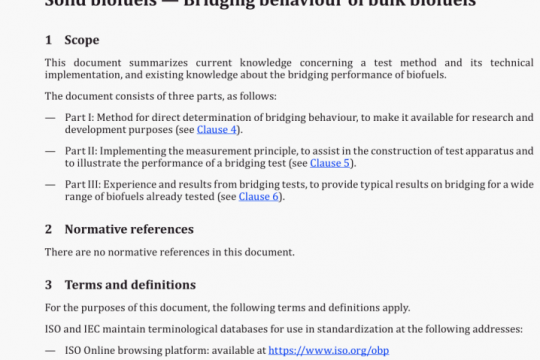ISO 23190 pdf free download
ISO 23190-2021 pdf free download.Traditional Chinese medicine – Determination of aristolochic acids in natural products by high-performance liquid chromatography (HPLC).
8.4.2 Standard solution
Dilute the stock solution of aristolochic acid I with methanol or 80 % methanol to prepare the standard
solution of aristolochic acid I (0,25 ug/ml).
8.4.3 Test solution I
Weigh 100 g of raw herbal materials to grind and pass it through an 80-mesh or finer sieve. Weigh accurately 0,5 g of the powdered raw herbal material in a conical flask with stopper. Add accurately 25 ml of 70 % methanol or 80% methanol and weigh. Ultrasonicate (powder. 250W; frequency, 40 kHz) for 40 minutes, cool, weigh again, make up the loss of weight with 70 % methanol or 80 % methanol, mix well and filter through a membrane filter (normal pore size 0,45 im) using the successive filtrate as the test solution.
8.4.4 Test solution II
Grind approximately lOg to 100 g of the extract, bolus, powder, pellet and tablet to fine powder, weigh an appropriate amount (equivalent to 0,5 g of aristolochic acid-containing raw herbal material) in a conical flask with stopper. Add accurately an appropriate amount of 70 % methanol or 80 % methanol with a ratio of material to liquid of 50:1. Ultrasonicate (powder, 250 W; frequency, 40 kHz) for 40 minutes, cool and then filter. Evaporate the filtrate to dryness, dissolve the residue in an appropriate amount of 70 % methanol or 80 % methanol to prepare a solution containing 20 mg aristolochic acid-containing raw herbal material per ml and filter through a membrane filter (normal pore size 0,45 itm) using the successive filtrate as the test solution.
8.4.5 Procedure
Inject 10 p1 of standard solution into the column of HPLC system to record the retention time and UV spectrum. Afterwards, inject 10 p1 to 20 p1 of test solution into the I-I PLC system to record the retention time and UV spectrum. Then compare the retention times and UV spectrums of the standard and test sample to determine whether aristolochic acid I is present in the test sample. The relative standard deviation of the retention time of aristolochic acid I should be not more than 5,0%.
8.5 Method validation
The described method has been shown to be suitable for some herbal drugs and their manufactured products, including Asari Radix et Rhizoma, Aristolochiae Fructus and Aristolochiae Herba. Its suitability for other herbal drugs shall be demonstrated or another validated method used. The method validation should conclude the relative standard deviation, the LOD, repeatability, sensitivity and stability.
8.6 Evaluation of qualitative results
The positive results are reliable if the recoveries of the sample and blank are 70 % to 125 % and the blank test shows no interference. If the recoveries of the sample and blank are less than 70 % or more than 125 %, the sample should be tested again.
The liquid chromatography-mass spectrometry (LC-MS) method is recommended for validating the result, see Annex B for additional information.
9 Sampling and preservation of samples
9.1 Sampling
Raw herbal materials shall refer to the World Health Organization’s Quality control methods for herbal materials.
Raw herbal materials received into the laboratory shall be accompanied by complete information such as the collected source and time and the name of the appraiser. Natural products received into the laboratory shall be accompanied by complete information such as the manufacturer and production time.
On receipt, a sample shall immediately be assigned a unique identification code which shall accompany it through all stages of the analysis to the reporting of the results. Samples shall be subject to an appropriate disposal review system and all records shall be kept.
10 Test report
For each test method, the test report shall specify the following:
a) all information necessary for the complete identification of the sample;
b) a reference to this document, i.e. ISO 23190:202 1;
c) the sampling method used;
d) the test method(s) obtained;
e) the test result(s) obtained;
f) all operating details not specified in this document, or regarded as optional, together with details of any incidents which have possibly influenced the test result(s);
g) any unusual features (anomalies) observed;ISO 23190 pdf download.




